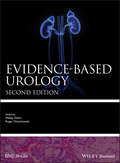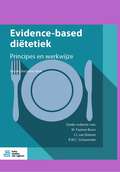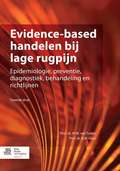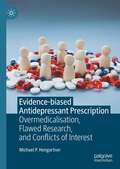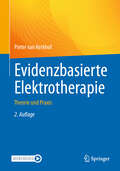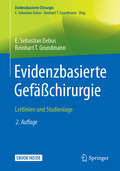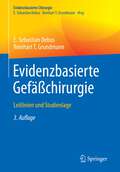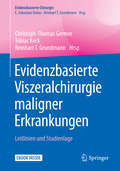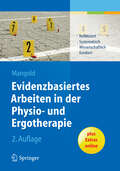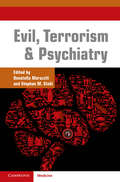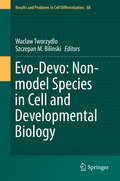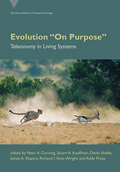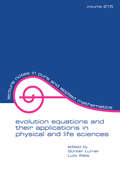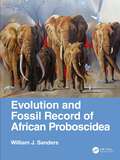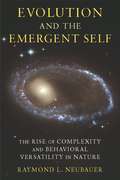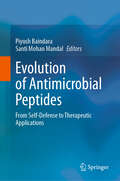- Table View
- List View
Evidence-based Urology (Evidence-Based Medicine #59)
by Philipp Dahm Roger R. DmochowskiThis unique book provides up-to-date information on the appropriateness of both medical and surgical treatment options for a broad spectrum of urological conditions based on the current best evidence. Written by an international team of authors that stand out through their specialty expertise and leadership in practicing evidence-based urology, this book provides practical recommendations for the care of individual patients. Each chapter addresses a series of focused clinical questions that are addressed in a systematic fashion, including a comprehensive literature search, a rating of the quality of evidence, and an assessment of ratio of benefit and harm of a given treatment option. Evidence-Based Urology is an invaluable source of evidence-based information distilled into guidance for clinical practice.
Evidence-based diagnostiek van het bewegingsapparaat
by Arianne Verhagen Jeroen AlessieValide diagnostiek vormt de grondslag van adequaat (para)medisch handelen. Dit boek geeft een overzicht van de wetenschappelijke onderbouwing van de anamnese, het lichamelijke onderzoek, specifieke testen en beeldvormend onderzoek bij patiënten met klachten aan het bewegingsapparaat.Deze 2e druk is volledig geactualiseerd. Bij het boek hoort een website met video’s van valide diagnostische handelingen met bijbehorende psychometrische gegevens. Verscheidene vormen van klinisch redeneren passeren in een korte introductie de revue, gevolgd door hoofdstukken over de begrippen ‘validiteit’ en ‘reproduceerbaarheid’ en de verschillen tussen een enkele test vergeleken met die van gecombineerde testen. Diverse hoofdstukken behandelen vervolgens de diagnostiek van patiënten met lage rugpijn, pijn aan de heup, knie, de voet, nek en schouder, elleboog en hand en pols. Elk hoofdstuk begint met een casus en sluit af met een terugblik daarop. Tevens wordt aandacht besteed aan de alarmsignalen (‘rode vlaggen’) die op ernstige pathologie kunnen wijzen.Evidence based diagnostiek van het bewegingsapparaat biedt een schat aan informatie voor huisartsen, fysiotherapeuten, studenten en overige professionals die belang hebben bij een actuele wetenschappelijke onderbouwing van de diagnostiek van klachten van het bewegingsapparaat.Arianne P. Verhagen is fysiotherapeut, manueel therapeut en klinisch epidemioloog. Zij is in 1999 gepromoveerd en vanaf juli 1999 tot januari 2018 werkzaam geweest als senior onderzoeker en projectleider bij de afdeling Huisartsgeneeskunde van het Erasmus MC. Van 2009 - 2014 lector ‘Diagnostiek’ aan de opleiding fysiotherapie van de Avans Hogeschool in Breda en deze functie is de aanleiding geweest voor dit boek. Vanaf 1 februari is Arianne hoofd opleiding en hoogleraar onderzoek aan de opleiding fysiotherapie van de UTS (University of Technology Sydney) in Australië. Jeroen Alessie is fysiotherapeut, educational science & technologist en als hogeschooldocent verbonden aan de opleiding fysiotherapie van de Avans Hogeschool in Breda.
Evidence-based diëtetiek: Principes en werkwijze
by M. Former-Boon J.J. van DuinenDit boek biedt voedingskundigen en diëtisten handvatten om met de best bewezen zorg, de beste zorg op maat te bieden. Het laat zien hoe wetenschappelijk onderzoek gecombineerd wordt met de ervaring van de diëtist, de wensen van de cliënt en andere informatiebronnen, zoals het internet.
Evidence-based diëtetiek: Principes en werkwijze
by M. Former-Boon J.J. van Duinen R.W.C. SchuurmanDit boek beschrijft een gestructureerde aanpak om te komen tot optimale voedingszorg. Het is bedoeld voor diëtisten in de eerste- en tweedelijnszorg én voor studenten. Het boek draagt bij aan de professionalisering van de diëtetiek in Nederland en Vlaanderen.Evidence-based diëtetiek is een belangrijk onderdeel van het diëtistisch zorgproces. Het is een transparante beroepsuitoefening waarbij het verlenen van professionele voedingszorg gebaseerd is op informatie uit het beste wetenschappelijke onderzoek, de kennis en ervaringen van de diëtist en situatie, waarden en voorkeuren van de patiënt. Door deze gestructureerde aanpak komen diëtisten samen met de patiënt tot de best passende behandeling. Deze vierde druk van Evidence-based diëtetiek. Principes en werkwijze gaat in op de vijf stappen van evidence-based diëtetiek. Iedere stap is uitgewerkt in een apart hoofdstuk: het formuleren van een duidelijke vraag, het zoeken en vinden van wetenschappelijke bronnen, het beoordelen van de kwaliteit van bronnen, en het implementeren en het evalueren van de behandeling. Aan de hand van praktijkvoorbeelden illustreert het boek hoe professionals de vijf stappen kunnen toepassen. De auteurs hebben veel kennis en ervaring op het gebied van evidence-based diëtetiek. Ze werken als diëtist of zijn betrokken bij toonaangevende onderzoeken op voedingsgebied, werkzaam in academische ziekenhuizen en/of als docent.
Evidence-based handelen bij lage rugpijn: Epidemiologie, preventie, diagnostiek, behandeling en richtlijnen
by B. W. Koes M.W. van TulderIn 2006 verscheen de eerste druk van de uitgave "evidence based handelen bij lage rugpijn". Aanleiding daarvoor was het grote aantal richtlijnen dat in de jaren daarvoor ontwikkeld werd bij de verschillende behandelaars in de eerste lijn (aparte richtlijnen voor bedrijfsartsen, huisartsen, fysiotherapeuten, CBO richtlijnen) etc. Het boek richt zich vooral op de wetenschappelijke onderbouwing van de richtlijnen. Het onderbouwt medisch en paramedische richtlijnen.
Evidence-based mental health practice: A Textbook
by Robert E. Drake Matthew R. Merrens David W. LyndeThis book explores some of the complex challenges in implementing EBPs, and highlights the meaningful opportunities that are inherent in this paradigm shift.
Evidence-biased Antidepressant Prescription: Overmedicalisation, Flawed Research, and Conflicts of Interest
by Michael P. HengartnerThis book addresses the over-prescribing of antidepressants in people with mostly mild and subthreshold depression. It outlines the steep increase in antidepressant prescription and critically examines the current scientific evidence on the efficacy and safety of antidepressants in depression. The book is not only concerned with the conflicting views as to whether antidepressants are useful or ineffective in various forms of depression, but also aims at detailing how flaws in the conduct and reporting of antidepressant trials have led to an overestimation of benefits and underestimation of harms. The transformation of the diagnostic concept of depression from a rare but serious disorder to an over-inclusive, highly prevalent but predominantly mild and self-limiting disorder is central to the books argument. It maintains that biological reductionism in psychiatry and pharmaceutical marketing reframed depression as a brain disorder, corroborating the overemphasis on drug treatment in both research and practice. Finally, the author goes on to explore how pharmaceutical companies have distorted the scientific literature on the efficacy and safety of antidepressants and how patient advocacy groups, leading academics, and medical organisations with pervasive financial ties to the industry helped to promote systematically biased benefit-harm evaluations, affecting public attitudes towards antidepressants as well as medical education, training, and practice.
Evidenzbasierte Elektrotherapie: Theorie und Praxis
by Pieter van KerkhofDieses Praxisbuch liefert Physiotherapeuten und Ergotherapeuten die ideale Grundlage zur Anwendung elektrotherapeutischer Behandlungsverfahren. Sie fragen sich, welche Mechanismen in der Elektrotherapie überhaupt wirken? Bei welchen Krankheitsbildern Low-TENS nach Birger Kaada angewandt werden kann? Oder welche Kontraindikationen gegen die Nutzung der Hochfrequenztherapien sprechen? Hier finden Sie die Antworten!Aus dem Inhalt:Schmerz, Schmerzhemmung und SchmerzverarbeitungPhysikalische Grundlagen zu Strom, Aktionspotenzialen u.v.m.Anwendung von Hochfrequenz, Muskelstimulation, Gleichstrom, TENS, Photobiomodulation und UltraschallErweitern Sie Ihr Behandlungsrepertoire um zahlreiche evidenzbasierte Anwendungsmöglichkeiten und rüsten Sie sich für den Einsatz der Elektrotherapie im therapeutischen Alltag.Plus: Zusatzmaterial wie z. B. Behandlungsprotokoll und Befundbogen zum Download
Evidenzbasierte Elektrotherapie: Theorie und Praxis
by Pieter van KerkhofWissen, das elektrisiert! Dieses Praxisbuch bietet Physiotherapeut*innen, medizinischen Bademeister*innen, Masseur*innen und Ergotherapeut*innen die perfekte Grundlage für die effektive Anwendung elektrotherapeutischer Behandlungsverfahren. Es liefert nicht nur fundiertes Know-how, sondern bringt Ihr Therapiewissen auf das nächste Level – klar strukturiert, praxisnah und nach neuesten Studien. Aus dem Inhalt: Schmerz, Schmerzhemmung und Schmerzverarbeitung, physikalische Grundlagen: Strom, Schall, Laser und mehr, Anwendungen: TENS, Muskelstimulation, Niederfrequenz und Gleichstrom, Laser, Ultraschall, Hochfrequenz, extra Kapitel zu Risikomanagement inklusive Implementierung, Fehlerquellen und Fragestellungen, Plus: Behandlungsprotokoll und Befundbogen als praktisches Zusatzmaterial zum Download. Neu in der 2. Auflage: Aktualisiert, überarbeitet und erweitert – basierend auf der neuesten Studienlage.
Evidenzbasierte Gefäßchirurgie: Leitlinien und Studienlage (Evidenzbasierte Chirurgie)
by E. Sebastian Debus Reinhart T. GrundmannDie rasche Entwicklung der therapeutischen Möglichkeiten in der Gefäßchirurgie spiegelt sich in der 2. Auflage des Buches wider, das weitgehend umgeschrieben wurde, um alle aktuellen internationalen Leitlinien und die zahlreichen Publikationen der letzten 3 Jahre zu operativen und endovaskulären Eingriffen zu berücksichtigen. Neu hinzugekommen sind Kapitel zu den Themen - Thoracic-Outlet-Syndrom - Akute intestinale Ischämie - Kompressionssyndrom des Truncus coeliacus - Popliteakompressionssyndrom - Tiefe Bein-Beckenvenenthrombose und postthrombotisches Syndrom - Vena cava-Filter. Damit ermöglicht das Buch für die 20 wichtigsten gefäßchirurgischen Indikationen eine gezielte evidenzbasierte Therapiewahl auf aktuellstem Stand. Zu jeder Indikation wird dargestellt:- Was empfehlen die nationalen und internationalen Leitlinien?- Welche wichtigen Informationen stehen nicht in den Leitlinien?- Welche Behandlungsergebnisse wurden in Metaanalysen und Cochrane-Reviews und weiteren randomisierten Studien veröffentlicht, und wie sind diese zu bewerten?- Wie sehen die Ergebnisse in Zentren und in der Fläche aus?Die Analyse der Daten führt zu gut begründeten, differenzierten Therapieempfehlungen, die unmittelbar in Klinik und Praxis angewandt werden können.
Evidenzbasierte Gefäßchirurgie: Leitlinien und Studienlage (Evidenzbasierte Chirurgie)
by E. Sebastian Debus Reinhart T. GrundmannDas bewährte Konzept der „Evidenzbasierten Gefäßchirurgie“ wurde auch für die 3. Auflage beibehalten: für die 21 wichtigsten gefäßchirurgischen Indikationsgebiete werden die Empfehlungen der nationalen und internationalen Leitlinien sowie die Ergebnisse von Metaanalysen, Cochrane-Reviews, randomisierten Studien und Registererhebungen systematisch und übersichtlich zusammengestellt.Dabei konzentriert sich die 3. Auflage auf den neuesten Wissens- und Diskussionsstand: auf der Basis einer umfassenden Literaturrecherche sind alle wichtigen Publikationen berücksichtigt, die seit Erscheinen der 2. Auflage in den Jahren 2018 bis ins Jahr 2022 erschienen sind, darunter 23 neue oder aktualisierte Leitlinien. Dem Leser wird damit nicht nur die Evidenz, sondern auch der neueste Wissens- und Diskussionsstand vermittelt.Zusätzlich wurde die 3. Auflage um ein Kapitel zum Thema Ulcus cruris erweitert, und erstmalig wurde für wichtige Kapitel ein zusätzlicher Abschnitt zum perioperativen Management eingefügt.
Evidenzbasierte Viszeralchirurgie maligner Erkrankungen: Leitlinien und Studienlage (Evidenzbasierte Chirurgie)
by Reinhart T. Grundmann Christoph-Thomas Germer Tobias KeckFür 15 wichtige viszeralchirurgische Indikationen bei malignen Erkrankungen ermöglicht dieses Buch eine gezielte evidenzbasierte Therapiewahl. Grundlagen sind die weltweit publizierten aktuellen Behandlungsergebnisse zu operativen Eingriffen und konservativem Vorgehen: was empfehlen die nationalen und internationalen Leitlinien? Welche wichtigen Informationen stehen nicht in den Leitlinien? Welche Behandlungsergebnisse wurden in Metaanalysen und Cochrane-Reviews und weiteren randomisierten Studien veröffentlicht, und wie sind diese zu bewerten? Wie sehen die Ergebnisse in Zentren und in der Fläche aus?Die Analyse der Daten führt zu gut begründeten, differenzierten Therapieempfehlungen, die unmittelbar in Klinik und Praxis angewandt werden können.
Evidenzbasierte medizinische Trainingstherapie
by Robin Bauer Sandro WolframDieses wissenschaftlich fundierte und umfassende Praxisbuch erläutert detailliert alle Aspekte der medizinischen Trainingstherapie. Es vereint theoretische Grundlagen, bewährte Trainingsmethoden und deren Umsetzung in die evidenzbasierte Praxis, ergänzt durch prägnante Zusammenfassungen. Von Kopf bis Fuß werden alle Körperbereiche behandelt, einschließlich der verschiedenen Körpersysteme und ihrer Krankheitsbilder. Mit diesem Buch lernen Sie, maßgeschneiderte Trainingspläne zu erstellen und Ihre Patient*innen in der Physiotherapie oder Sporttherapie kompetent zu Themen wie Ernährung, Supplemente, Schlaf und mentales Training zu beraten. Aus dem Inhalt: Anatomische und physiologische Grundlagen, Teilbereiche der medizinischen Trainingstherapie wie z. B. Kraftausdauer, Maximalkraft, Schnellkraft, Explosivkraft, Reaktivkraft, Ausdauer, Propriozeption und Beweglichkeit, altersabhängige und krankheitsassoziierte Veränderungen und deren Einflüsse auf die Trainingsplanung, Befund, Training und beeinflussende Faktoren wie mentaler Status und Muscle Memory Effekt u.v.m., Krankheitsbilder des Nervensystems, wie M. Parkinson und Multiple Sklerose, Training nach Covid-19, bei Migräne, Demenz und koronaren Herzerkrankungen.
Evidenzbasierte psychische Gefährdungsbeurteilung: Prinzipien und Instrumente für Entscheider in der betrieblichen Praxis (essentials)
by Holger Pfaff Lara Lindert Sabrina ZeikeDieses essential stellt ein wissenschaftlich fundiertes System der psychischen Gefährdungsbeurteilung vor, das den gesetzlichen Vorgaben entspricht. Es zeigt auf, welche Schritte ein umfassendes und betriebsspezifisches Gefährdungscontrolling beinhaltet und welche Rolle der psychischen Gefährdungsbeurteilung in diesem Prozess zukommt. Die Methode der evidenzbasierten psychischen Gefährdungsbeurteilung dient als Grundlage, um Gefährdungen adäquat zu erfassen und wirksame (Gegen-)Maßnahmen einzuleiten und hilft bei der Implementierung des Gefährdungscontrollings. So kann ein kontinuierlicher und nachhaltiger Lernprozess im Unternehmen angeregt werden, von dem Arbeitnehmer und Arbeitgeber profitieren.
Evidenzbasiertes Arbeiten in der Physio- und Ergotherapie
by Sabine MangoldWer heilt hat Recht. Dieser Grundsatz reicht heute bei der Leistungsabrechnung gegenüber Kostenträgern nicht mehr aus: Wissenschaftliche Belege werden gefordert. Im Rahmen der Akademisierung der Berufe Physiotherapie und Ergotherapie wird evidenzbasiertes Arbeiten daher immer mehr zum Muss. Diese Erstauflage erläutert klar und strukturiert die einzelnen Ebenen des Evidenzbasierten Arbeitens und nimmt somit die Scheu vor diesem neuen Gebiet. Zusätzlich zum theoretischen Wissen liefern konkrete Beispiele aus dem Berufsalltag einen praktischen Zugang. Das Buch reflektiert kritisch die Evidenzbasierte Praxis (EBP) und zeigt Therapeuten Möglichkeiten, aber auch Grenzen auf. In diesem Werk wird besonderen Wert auf Vollständigkeit und Tiefe gelegt. Für Jeden am Thema Interessierten ist etwas dabei: Sowohl praxisnahe und schnell umsetzbare Anleitungen für diejenigen, die in das wissenschaftliche Arbeiten einsteigen möchten, als auch das Rüstzeug für Leser, die wissenschaftlich arbeiten möchten.
Evidenzbasiertes perioperatives Management in der Viszeralchirurgie: Leitlinien, Empfehlungen und Studienlage (Evidenzbasierte Chirurgie)
by E. Sebastian Debus Reinhart T. GrundmannDas Buch bildet die Basis für eine evidenzbasierte perioperative Behandlung bei allen häufigen viszeralchirurgischen Operationen. Die einzelnen Maßnahmen (wie Ernährung, Analgesie, perioperative Antibiotikaprophylaxe und Hämotherapie) werden auf der Grundlage der weltweit publizierten Empfehlungen bewertet. Berücksichtigt sind die nationalen und internationalen Leitlinien, die Ergebnisse von Metaanalysen, Cochrane-Reviews und anderen randomisierten Studien sowie weitere verfügbare Informationen, die nicht in den Leitlinien stehen. Differenzierte, gut begründete Vorschläge ermöglichen ein patientengerechtes und wissenschaftlich fundiertes perioperatives Management in der Klinik. Ganz aktuell: ein Kapitel zum perioperativen Management bei COVID-19-Patienten!
Evil, Terrorism and Psychiatry: Stahl Essential Psychopharmacology Handbooks
by Stephen M. Stahl Donatella MarazzitiTerrorism has dominated the domestic and international landscape since 9/11. Determining what drives people to commit acts of terrorism is no easy task. The important new book fills a gap in the psychology and psychiatry literature by examining the relationship between evil and mental illness, and in particular amongst terrorists. How can evil, a characteristic of human nature, become extreme, intent on destruction and lead to acts of terrorism? Featuring contributions from leading experts in this field, Evil, Terrorism and Psychiatry explores whether there are specific personality traits, psychological characteristics or psychopathological conditions that may favour a lack of control of violence in terrorists. It also offers possible novel prevention strategies to help understand and prevent these acts in future. Featuring articles from a special issue of CNS Spectrums, this book also includes brand new chapters found exclusively in this book.
Evo-Devo: Non-model Species in Cell and Developmental Biology (Results and Problems in Cell Differentiation #68)
by Waclaw Tworzydlo Szczepan M. BilinskiEvolutionary developmental biology or evo-devo is a field of biological research that compares the underlying mechanisms of developmental processes in different organisms to infer the ancestral condition of these processes and elucidate how they have evolved. It addresses questions about the developmental bases of evolutionary changes and evolution of developmental processes. The book’s content is divided into three parts, the first of which discusses the theoretical background of evo-devo. The second part highlights new and emerging model organisms in the evo-devo field, while the third and last part explores the evo-devo approach in a broad comparative context. To the best of our knowledge, no other book combines these three evo-devo aspects: theoretical considerations, a comprehensive list of emerging model species, and comparative analyses of developmental processes. Given its scope, the book will offer readers a new perspective on the natural diversity of processes at work in cells and during the development of various animal groups, and expand the horizons of seasoned and young researchers alike.
Evolution "On Purpose": Teleonomy in Living Systems (Vienna Series in Theoretical Biology)
by Peter A. Corning, et al.A unique exploration of teleonomy—also known as &“evolved purposiveness&”—as a major influence in evolution by a broad range of specialists in biology and the philosophy of science.The evolved purposiveness of living systems, termed &“teleonomy&” by chronobiologist Colin Pittendrigh, has been both a major outcome and causal factor in the history of life on Earth. Many theorists have appreciated this over the years, going back to Lamarck and even Darwin in the nineteenth century. In the mid-twentieth century, however, the complex, dynamic process of evolution was simplified into the one-way, bottom-up, single gene-centered paradigm widely known as the modern synthesis. In Evolution &“On Purpose,&” edited by Peter A. Corning, Stuart A. Kauffman, Denis Noble, James A. Shapiro, Richard I. Vane-Wright, and Addy Pross, some twenty theorists attempt to modify this reductive approach by exploring in depth the different ways in which living systems have themselves shaped the course of evolution.Evolution &“On Purpose&” puts forward a more inclusive theoretical synthesis that goes far beyond the underlying principles and assumptions of the modern synthesis to accommodate work since the 1950s in molecular genetics, developmental biology, epigenetic inheritance, genomics, multilevel selection, niche construction, physiology, behavior, biosemiotics, chemical reaction theory, and other fields. In the view of the authors, active biological processes are responsible for the direction and the rate of evolution. Essays in this collection grapple with topics from the two-way &“read-write&” genome to cognition and decision-making in plants to the niche-construction activities of many organisms to the self-making evolution of humankind. As this collection compellingly shows, and as bacterial geneticist James Shapiro emphasizes, &“The capacity of living organisms to alter their own heredity is undeniable.&”
Evolution Equations and Their Applications in Physical and Life Sciences: Proceedings Of The Bad Herrenalb (karlsruhe), Germany, Conference (Lecture Notes in Pure and Applied Mathematics)
by G LumerThis volume presents a collection of lectures on linear partial differntial equations and semigroups, nonlinear equations, stochastic evolutionary processes, and evolution problems from physics, engineering and mathematical biology. The contributions come from the 6th International Conference on Evolution Equations and Their Applications in Physica
Evolution and Fossil Record of African Proboscidea
by William J. SandersThis book details the long, diverse, and complex phylogenetic history of elephants and their fossil relatives (the Proboscidea), whose origin is deeply embedded some 60 million years ago in Africa. Most of the major evolutionary events of proboscideans occurred in Africa, and these are examined in their geological, paleoecological, geographic, and faunal contexts. Updated information about feeding adaptations, taxonomy and systematics, genetics, and site occurrences is included and summarized in tables, figures, and charts. This is the first comprehensive review of African proboscideans and illustrates the need to more actively protect elephants and ensure their survival in modern ecosystems. Key Features: Provides a comprehensive systematic review of the African proboscidean fossil record Includes a summary of taxonomy, geochronology, biogeography and morphology Documents major faunal events including those associated with hominin origins Synthesizes new data from genomic, isotopic, and microware analyses Emphasizes the role of elephants in ecosystems and the importance of conservation
Evolution and the Emergent Self: The Rise of Complexity and Behavioral Versatility in Nature
by Raymond NeubauerEvolution and the Emergent Self is an eloquent and evocative new synthesis that explores how the human species emerged from the cosmic dust. Lucidly presenting ideas about the rise of complexity in our genetic, neuronal, ecological, and ultimately cosmological settings, the author takes readers on a provocative tour of modern science's quest to understand our place in nature and in our universe. Readers fascinated with "Big History" and drawn to examine big ideas will be challenged and enthralled by Raymond L. Neubauer's ambitious narrative.How did humans emerge from the cosmos and the pre-biotic Earth, and what mechanisms of biological, chemical, and physical sciences drove this increasingly complex process? Neubauer presents a view of nature that describes the rising complexity of life in terms of increasing information content, first in genes and then in brains. The evolution of the nervous system expanded the capacity of organisms to store information, making learning possible. In key chapters, the author portrays four species with high brain:body ratios—chimpanzees, elephants, ravens, and dolphins—showing how each species shares with humans the capacity for complex communication, elaborate social relationships, flexible behavior, tool use, and powers of abstraction. A large brain can have a hierarchical arrangement of circuits that facilitates higher levels of abstraction.Neubauer describes this constellation of qualities as an emergent self, arguing that self-awareness is nascent in several species besides humans and that potential human characteristics are embedded in the evolutionary process and have emerged repeatedly in a variety of lineages on our planet. He ultimately demonstrates that human culture is not a unique offshoot of a language-specialized primate, but an analogue of fundamental mechanisms that organisms have used since the beginning of life on Earth to gather and process information in order to buffer themselves from fluctuations in the environment.Neubauer also views these developments in a cosmic setting, detailing open thermodynamic systems that grow more complex as the energy flowing through them increases. Similar processes of increasing complexity can be found in the "self-organizing" structures of both living and nonliving forms. Recent evidence from astronomy indicates that planet formation may be nearly as frequent as star formation. Since life makes use of the elements commonly seeded into space by burning and expiring stars, it is reasonable to speculate that the evolution of life and intelligence that happened on our planet may be found across the universe.
Evolution of Antimicrobial Peptides: From Self-Defense to Therapeutic Applications
by Piyush Baindara Santi Mohan MandalOver the last century, antibiotics have been a primary treatment for infectious diseases, and indiscriminate use by both healthcare providers and patients has led to the rapid emergence of resistant pathogens. Multidrug-resistant pathogens and infective agents are an urgent threat to global health, and this issue has created a critical need for the investigation of alternatives to conventional antibiotics. Antimicrobial peptides (AMPs) have emerged as promising alternative therapeutics, with studies on their mechanisms and applications an area of intense interest in agricultural science, physiology, and medicine. AMPS are naturally occurring components of the host defense system, and functional throughout all orders of life, from prokaryotes to eukaryotes. They are potent molecules with broad spectrum activities against infectious agents, including bacteria, fungi, viruses, and parasites. AMPs have demonstrated therapeutic potential against non-infectious diseases like chronic inflammation and cancer, and have been found to have potential activities against slow-growing bacteria, such as biofilms. This book summarizes the current available research on AMPs, including discovery, screening, and characterization, for therapeutic applications. It discusses molecular biology, proteomics, genomics, and bioinformatics approaches. In addition, it covers AMP classification and evolutionary studies, from prokaryotes to eukaryotes.
Evolution of Atopic Dermatitis in the 21st Century
by Ichiro Katayama Hiroyuki Murota Takahiro SatohThis comprehensive guide offers a state-of-the-art overview of basic and clinical aspects of atopic dermatitis (AD). The name "atopic dermatitis" was first used in 1933, and Drs. Lewis Webb Hill and Marion B. Sulzberger presented their report "Evolution of atopic dermatitis" in 1935. Their observations accurately forecasted the contemporary issues in the management of the condition, such as the conclusions that should be drawn from our understanding of the pathogenesis of AD, and the use of steroids as the main treatment. Several aggravating factors have recently been identified, and these also need to be addressed. In this context, the expert contributors to this book describe and discuss the evolution of atopic dermatology from Sulzberger's era to the present day, including clinical manifestations, etiopathology and treatment. In addition, it explores skin care intervention, the role of microbiom and GWAS studies, and presents unique, previously unpublished cohort studies. It provides insights into the dynamic changes in AD since Sulzberger introduced topical steroids for its treatment. It is a valuable resource for dermatologists, medical practitioners and researchers who are interested in atopic dermatology.
